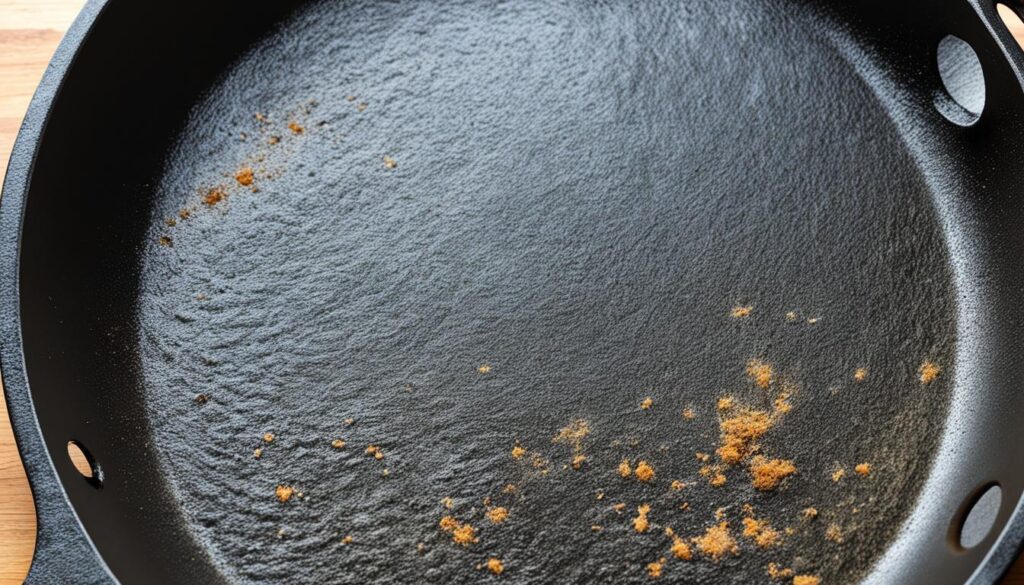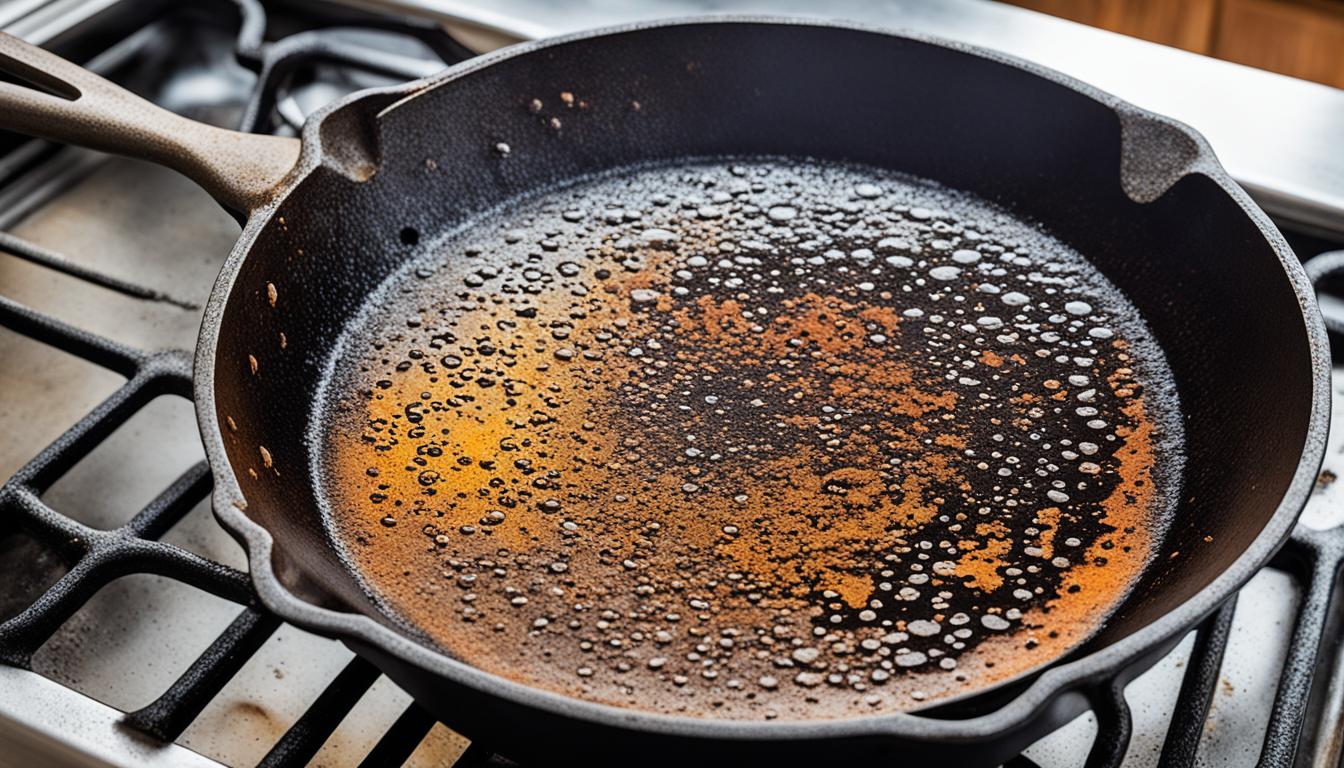Ever noticed food sticking to your cast iron skillet, even after seasoning it? Achieving a truly non-stick cast iron requires proper seasoning. But what is seasoning, and how do you do it right?
Key Takeaways
- Seasoning creates a smooth, non-stick surface on cast iron by baking thin layers of oil onto the pan.
- New cast iron skillets often come pre-seasoned but may need additional seasoning over time.
- To season, coat the pan with a thin layer of high smoke point oil and bake at 450-500°F for an hour.
- Repeating the seasoning process multiple times leads to a better coating.
- Regularly cooking fatty foods helps maintain and enhance the seasoning.
Table of Contents
What Does Seasoning a Cast Iron Skillet Mean?
Seasoning a cast iron skillet means making it non-stick by adding thin layers of oil. These layers are baked onto the pan, creating a tough, protective coating. This coating prevents rust and makes cooking easier.
Seasoning Forms a Non-Stick Coating
A well-seasoned cast iron skillet has a smooth surface that food doesn’t stick to. Over time, with cooking, this surface becomes even better. So, the cast iron seasoning definition is about how well your pan cooks because of this non-stick layer.
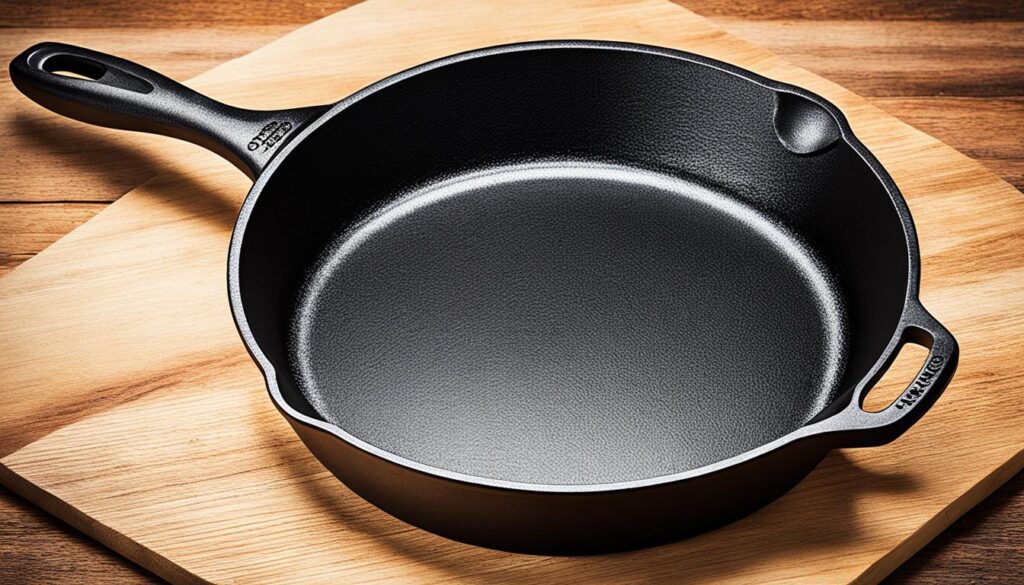
Seasoning Helps Prevent Rusting
Seasoning also stops rust on a cast iron pan. The layer of polymerized oil keeps water from touching the iron itself. This is key to keeping your pan in great shape.
| Skillet Model | Cooking Surface Size | Coating Durability |
|---|---|---|
| Oster CKSTSKFM12-ECO | 12″ x 12″ | DuraCeramic (400% more durable than Teflon) |
| Oster CKSTSKFM16W-TECO | 12″ x 16″ | Titanium-Infused DuraCeramic |
| Hamilton Beach 38528R | 12″ x 15″ | Durathon Ceramic (4x more durable than traditional nonstick) |
The table shows electric skillets that have long-lasting ceramic coatings. These coatings make them as good as seasoned cast iron in terms of non-stick.
Preparing an Unseasoned or Rusty Skillet
If you have an unseasoned cast iron skillet or it’s rusty, no need to panic. You can bring it back to life with a little work. Start by scrubbing it well with warm, soapy water to get rid of rust or debris. After cleaning, make sure it’s dry, leaving no moisture.
Then, it’s time to prepare the cast iron for seasoning. Apply a very thin layer of cooking oil to the pan, inside and outside. Remember, too much oil can make it sticky. So, use a paper towel to remove any excess oil until there’s just a light coating.
Scrub and Dry the Pan Thoroughly
To top up that rusty cast iron skillet, start with a thorough scrub. Use a stiff brush and warm, soapy water. Clear off grime, rust, or old seasoning. After cleaning, rinse well and ensure it completely dries to prevent future rust.
Apply a Thin Layer of Oil
Once your pan is clean and dry, applying oil is next. Use a neutral, high smoke-point oil like grapeseed, canola, or avocado. Dab a bit of oil over the pan, then wipe away extra to avoid stickiness. For a new electric skillet, consider looking at this guide on finding the perfect electric skillet size.

Your cast iron skillet is now set for the oven seasoning step. A bit of work now will give you many meals on a refurbished cooking surface.
| Skillet Model | Cooking Surface | Weight | Release Date |
|---|---|---|---|
| Oster CKSTSKFM05 16-Inch | 16″ x 12″ | 4.24 lbs | March 2008 |
| Oster CKSTSKFM16W-TECO Titanium | 16″ x 12″ | 7.75 lbs | July 2018 |
| Elite Platinum EG-6203 | 16″ x 13″ | 9.88 lbs | March 2017 |
| Hamilton Beach 38528R | 15″ x 12″ | 7.6 lbs | August 2017 |
Oven Seasoning Process
The cast iron oven seasoning method is a great way to make your skillet last longer. Start by preheating your oven to a high temperature, like 450-500°F (230-260°C). Put an old baking sheet on the rack below to catch drips.
Bake the Oiled Skillet for 30-60 Minutes
When your oven is ready, put your cast iron skillet upside down on the middle rack. Bake it for 1 hour. This makes the oil on the surface turn into a strong, non-stick layer. You might see some smoke, but don’t worry, it’s normal.
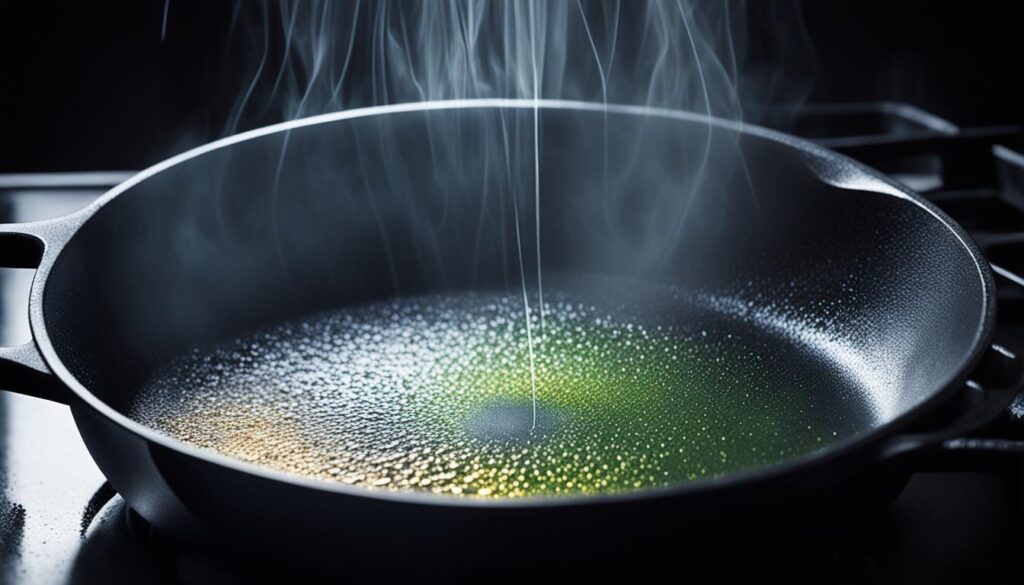
Allow the Skillet to Cool Slowly
After an hour, turn off the oven. Let the skillet stay in the cooling oven. This step is crucial for making the seasoning stick well. Once the skillet is cool, take it out.
To get the best results, do this cast iron oven seasoning method 3-4 times. Make sure the skillet is fully cool before each new session. This technique creates a strong, non-stick layer over the skillet.
Best Oils for Seasoning Cast Iron
Choosing the right cast iron seasoning oil is vital for a lasting non-stick layer. The smoke point for seasoning needs consideration. This is the temp where oil burns and forms a dry, non-stick layer.
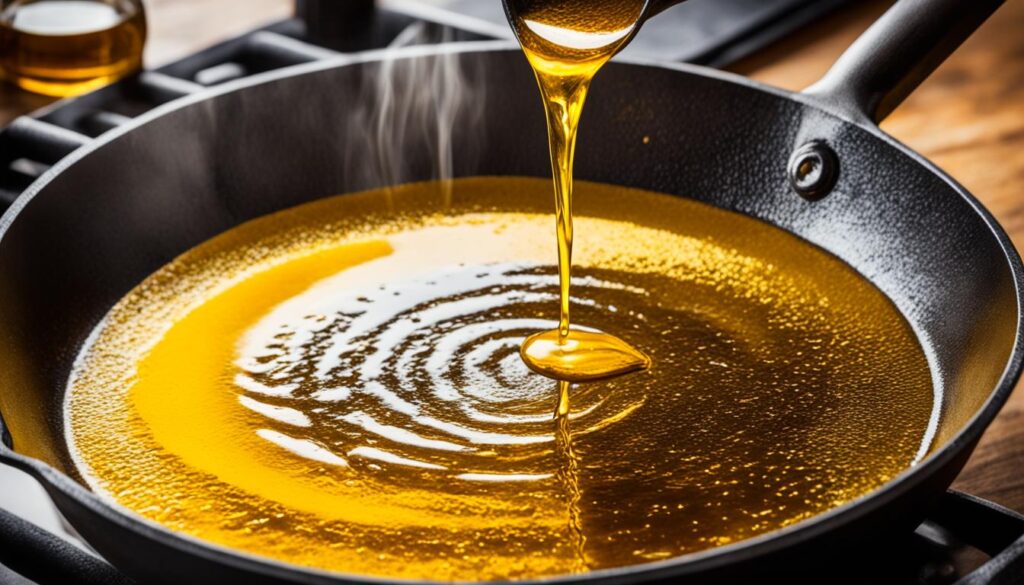
Grapeseed, Avocado or Canola Oil
Grapeseed, avocado, and canola oils are top choices for seasoning cast iron. They work well due to their high smoke points. For oven seasoning, grapeseed is great because it’s high in unsaturated fats.
Avocado oil also stands out with its 500-520°F smoke point. It creates a tough seasoning layer. Plus, it has more monounsaturated fats, which some people find healthier for high-heat cooking.
Consider the Oil’s Smoke Point
The cast iron seasoning oil must have a smoke point above 500°F. This prevents burning and uneven layers. Oils like flaxseed and olive have lower smoke points, so they’re not ideal for seasoning.
Canola, vegetable, and shortening are good alternatives. But, you must watch their smoke points during seasoning. Saturated fats from bacon grease and butter are tasty but don’t help build a strong seasoning.
| Oil | Smoke Point | Price (32 oz) | Ratings |
|---|---|---|---|
| Grapeseed Oil | 400-420°F | $12.99 | 4/5 |
| Avocado Oil | 500-520°F | $14.99 | 4.5/5 |
| Canola Oil | 400-450°F | $2.99 | 4/5 |
| Flaxseed Oil | 225°F | $34.99 | 3.5/5 |
Some recommend a special blend for seasoning. It includes grapeseed oil, linoleic sunflower oil, and beeswax. Applying it thinly after each wash helps keep your cast iron in top shape.
Maintaining Seasoning with Regular Use
Keeping your seasoned cast iron in top shape is crucial for its long life and non-stick goodness. As soon as you get a good seasoning layer down, it’s all about using your pan right to keep it up. This means sticking to proper cast iron cooking tips every time you cook.
Cook Foods with High Fat Content
I always keep my seasoning in check by cooking things with lots of fats in them. When you fry food in your pan, like chicken or bacon, the seasoned layer gets stronger. The fat and heat from the oil work together to make the seasoning tougher. It basically ‘re-seasons’ your pan every time, making it more bonded and slick.
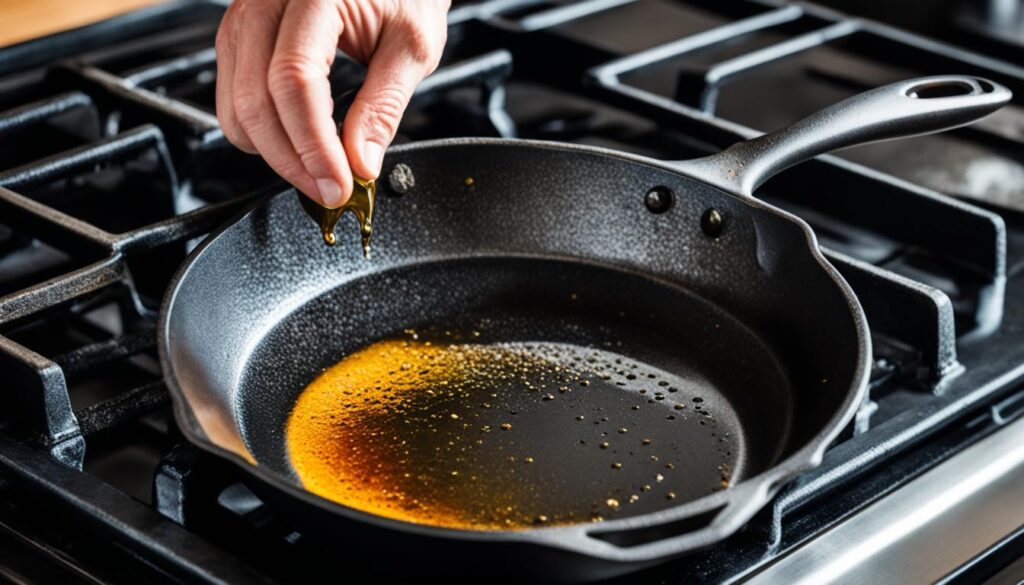
Avoid Highly Acidic Foods Initially
It’s hard not to reach for those tasty acidic foods, but I stay away when my pan’s still new. Tomatoes, citrus fruits, and vinegar are a no-go at first. They might damage the nice seasoning you’ve built. Once the seasoning is well set, you can start using your pan for these foods safely.
Focus on using fats and steering clear of acids early to keep your skillet’s look flawless. Taking care of your seasoned cast iron well also means it’ll get better with time. It’ll be more non-stick and add more flavors to your food the more you use it.
Signs of Eroding Seasoning
Over time, the best-seasoned cast iron skillet can lose its coating. You’ll notice the signs of unseasoned cast iron easily. A dull or patchy surface means your seasoning is getting thin. And if food sticking to the cast iron starts being a problem, it’s another clue.
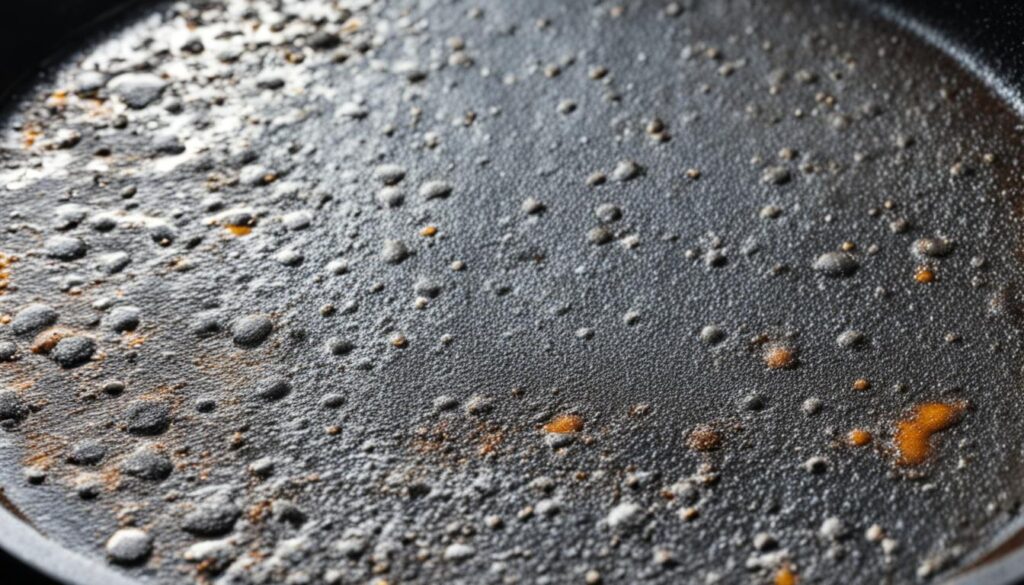
Dry or Patchy Surface
If your cast iron pan doesn’t look semi-glossy black all over, it’s a sign. Dry, rough areas show your coating needs help. This look is a classic sign of unseasoned cast iron.
Food Sticking to the Pan
Seasoning is meant to prevent food from sticking. When food starts sticking to your skillet, it’s a clear sign. Sticking and staining mean it’s time for new seasoning oil.
Don’t worry if you see these signs. Fixing it is simple. Clean your pan well, then bake with a thin oil coat. With care, your cast iron will stay a great kitchen tool.
Restoring Flaking or Lost Seasoning
If your cast iron seasoning is coming off, don’t panic. It’s a sign that the layers didn’t stick well at first. But fixing it is simple. First, use a stiff brush or salt to get rid of loose bits. Then, wash and dry the pan completely.
Now, cover the whole pan with a thin layer of oil. Go for an oil that smokes a lot, such as grapeseed. You might need to do this process a few times. Heat your oven to 400°F, then put the pan in upside down. Let it bake for an hour. Make sure it’s cool before the next round.
Don’t lose hope. With a bit of work, you can get your cast iron looking great again. Remember, it’s important to let each layer of seasoning fully stick before adding more. And don’t forget to cook with oily foods like bacon. This will make your seasoning strong and shiny.
